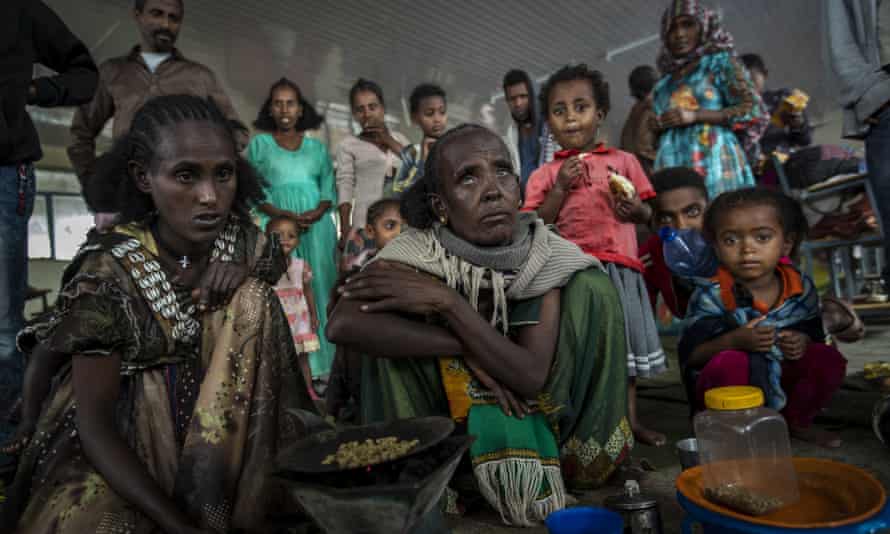“The looming famine in Tigray is an avoidable catastrophe”, The Guardian
George Monbiot, Opinion, London, 30 June 2021
The ruination of a once-thriving area of Ethiopia is the result of war and its associated crimes. The world needs to wake up

George Monbiot, Opinion, London, 30 June 2021
The ruination of a once-thriving area of Ethiopia is the result of war and its associated crimes. The world needs to wake up

It is hard to believe it’s happening again, even harder to believe that so few people seem to know or care. A massive famine is unfolding in Tigray in northern Ethiopia. Five million people are in need of food aid, and perhaps 900,000 are already starving.
In other words, it’s looking horribly reminiscent of the start of the 1984 famine, in which a million people died, most of them in Tigray. Like the last cataclysm, this has nothing to do with “natural causes”. It’s caused by war and its associated crimes. This time, however, the man in charge is a Nobel peace laureate: the Ethiopian prime minister, Abiy Ahmed. A great weight of evidence suggests that his troops, and those of his Eritrean allies, are using hunger as a weapon of war.
In February, Abiy’s government dissolved the boards of the most effective aid groups: the Relief Society of Tigray and the Tigray Development Association. Since then, their warehouses have been destroyed by soldiers, their offices looted and their vehicles stolen. The Ethiopian and Eritrean armies have blocked supply lines, turned back convoys of food and medicine, burned grain stores, felled orchards, slaughtered oxen and ordered farmers not to till their fields.
This week the Ethiopian government declared a ceasefire, ostensibly to “enable farmers to till their land”, but more plausibly to regroup after an astounding reversal: Tigrayan rebels have recaptured the regional capital. In any case, it’s too late. Tillage should have happened over the past three months. People who are starving today can’t wait for possible harvests in November.
Like his homicidal predecessor, Mengistu Haile Mariam, Abiy flatly denies the famine. Last week he claimed: “There is no hunger in Tigray.” If justice is ever done, we might one day witness the remarkable spectacle of a Nobel laureate on trial for crimes against humanity.
All this would be bad enough. But what sharpens the crime is that Tigray was, until the war began last November, a world-renowned success story.
The traditional explanation of famine, which appears to resist all evidence, is that hunger is caused by a surfeit of people. A rising population overtaxes the land, which can no longer provide sufficient food for those who depend on it. But a fascinating study shows that in Tigray the opposite has happened.
It used photographs dating back to 1868, taken from the same vantage points, to assess the condition of the land. Since then, the population of Ethiopia has risen from 6.6 million to 115 million. A catastrophe? Far from it. The researchers found more trees, more vegetation, less erosion, less degradation. The region, they discovered, is “greener than at any time in the last 145 years”.
Why? Because the main driver of land degradation and hunger is not population. It’s policy. In 1868, the best land was owned by feudal lords. Other people were driven on to steep slopes. Pressed to the margins, without secure tenure, they were forced into destructive forms of land use: mostly uncontrolled grazing. But in the 1970s, land was redistributed to the people. Beginning in the 1980s, the rebels in Tigray, who later formed the national government, launched a programme to protect the soil, catch rainwater and reforest the land. Livestock were fenced out of large areas, steep slopes were terraced, stone walls and soil bunds were built to stop erosion, and trees planted and ponds dug to prevent water from flashing off the land.
The scale of these works is astonishing. Every fit person over the age of 18 spends 20 days a year on collective projects to rehabilitate the land. Entire landscapes, torn apart by gullies and sheet erosion, have been remodelled. The stone and soil moved by hand must amount to millions of tonnes. This might explain an extraordinary finding: the greenest places in Tigray are those with the highest population density. Because of the vast effort required, these works would have been impossible with fewer hands.
There have been similar results in other places: the Karoo Midlands in South Africa, Machakos in Kenya, the Loess plateau in China and the Adarsha catchment in India. In all these cases, population growth has been accompanied by environmental repair.
But Tigray is the outstanding example. The restoration works have caused a huge reduction in soil erosion and water loss, a resurgence of wildlife and improvements in crop production that have easily outstripped population growth. Incomes have risen. Children spend more time at school. In 2015-2016, when a major drought struck, the system helped to avert famine. The reason for its success is local control and enthusiasm for the programme: people feel it belongs to them. As welfare and security have improved, and women have greater rights and opportunities, population growth has fallen.
Of course, there are plenty of places where higher numbers of people, combined with total institutional failure, harm both the natural world and human welfare. But the important point is that population growth, degradation and famine are not intrinsically connected. What counts is the quality of government.
So there are no excuses. No part of the catastrophe in Tigray is natural or inevitable. Abiy, with his allies in Eritrea, is turning a thriving, prosperous region into the scene of another historic disaster. And he won’t stop until the world wakes up.
The Guardian